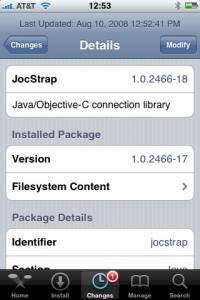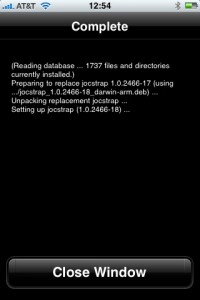News tagged ‘Java’
Firmware 3.0 Safari benchmarks

While still in beta, the Firmware 3.0 includes a new version of Safari that integrates the latest WebKit. It uses SquirrelFish Extreme ("Nitro") as an engine for JavaScript. The benchmarkes shows that the new firmware is 3 to 10 times faster, depending on the type of action.
Developing iPhone Applications using Java [Video]
Here is a video from googletalks, where Arno Puder speaks about using Java for developing iPhone apps.
iPhone Mobile Browser Share Now… 66.61%
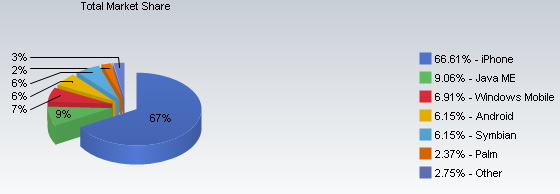
is reporting that the iPhone owns 66.61% share, which compare to Java2ME (RIM’s OS) 9.06% and WinPho’s 6.91%, Android and Symbian’s 6.15% each, and Palm’s 2.37% and the assorted others’ at 2.75%.
Android, which Google released in October, came in fourth with 6.15 percent, following No. 2 Java ME's 9.06 percent and No. 3 Windows Mobile's 6.91 percent.
iSutra updated to version 1.1 [Cydia]

, this nice application. Thanks to jailbreaking and Cydia we can run and use. It updated to vesrion 1.1. Just in time for Valentines Day. Several bugs fixed. It is also translated into Russiand and Portugese. If you're not familiar, watch the video .
Java4iPhone.com has moved to iPhoneRoot.com

Our site is more about iPhone, than just Java for iPhone. So Java4iPhone.com has moved to . All posts, comments, links are saved. You can still access all info via java4iphone.com. However, please, update your links and feeds. Sorry for the inconvenience.
Thank you.
Adding search to Safari browser in iPhone
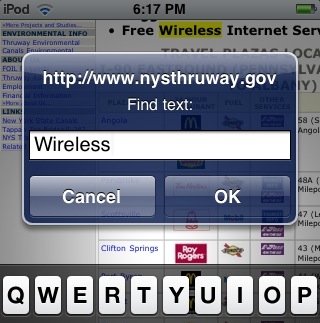
Now iPhone users can search in Safari browser. This is one of the features I was waiting for a long time.
Here is what you need to do: open Safari and go to , click and follow the instructions which are:
Copy and Paste
One more solution for CopyPaste functionality using javascript and bookmarks.
 Leave a comment, read comments [1]
Leave a comment, read comments [1]
Step-by-step Tutorials
Here are the links to tutorials on Java4iPhone.
Unlock, jailbreak, activate, etc:
Java:
Other:
Java4iPhone теперь с поиском от Google
Good news everyone. Thanks to Google you can now use search on Java4iPhone. Use the form in the right top corner.

Jocstrap, bridge between Java and Objective-C, is updated
JocStrap - Java/Objective-C connection library, new version 1.0.2466-18 (was 1.0.2466-17).
Jocstrap is a bridge between Java and Objective-C. This is needed to write Java applications for IPhone. Just in case you don't have Cydia and Java installed on your IPhone, follow these instructions: Tutorial: install Java on the IPhone.
Broadcast video live from iPhone
has released its mobile video streaming application for jailbroken iPhones to the public. The service allows users to broadcast video live from their phones using Wi-Fi or the EDGE network which can be viewed on Qik’s site or through its embeddable player. Unfortunately, the application is only compatible with phones running the 1.1.4 firmware.
Users running the 2.0 version of the software will need to wait for Qik to release a compatible version, which the company expects to do in the near future. Unfortunately, it’s likely that the application won’t be available through the official App Store, as Apple still hasn’t enabled video capture using the phone’s integrated camera.
WinterBoard - HTML as a background
![]()
Winterboard is amazing. Saurik, the developer of Winterboard, has just added dynamic backgrounds. Your background can now be an HTML web page using webkit. The possibilities are endless. He threw together a small theme called “Saurik” that fades in and out between two images as an example. But so much more can be done with this.
Comments from Saurik:
So, while staring at the desktop, I realized “wait, why don’t I make that a website? then you could do all kinds of neat things with it!”. This dream has been made a reality with the latest version of WinterBoard. There is a new file you can add called Wallpaper.html which puts a UIWebDocumentView behind SpringBoard.
IPhone web-based voice control from AT&T
AT&T has developed a software trick that will recognize voice commands without the need for specialized voice recognition software. It is based on a new version of AT&T's WATSON speech recognition engine.
As long as the software used to access Speech Mashups obeys certain web standards, particularly an AJAX framework and JavaScript, the technology can capture voice commands, interpret them at a remote server, and send them back to the device in a language a website or program can understand -- all without installing a dedicated app or plugin.
In a prototype mobile version of the YellowPages website, AT&T in a research video shows an iPhone user entering the business name and location into text fields on the page just by speaking them at the appropriate times. While typing would work in such a case, the company claims that voicing the information is faster and more convenient.
via appleinsider
Java for IPhone / IPhone 3G firmware 2.0 exists
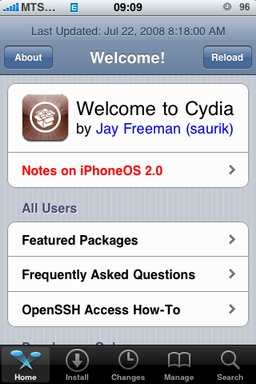

After successfull of the IPhone/IPhone 3G with firmware 2.0 it is possible to install . And what is more exciting, there are many applications there, including Java.
Related articles:
screenshots are from iphoneapps.ru
Safari benchmark - 2.0 is faster than 1.1.4
There is not much defference between Safari 1.1.4 and 2.0. But Under the hood, MobileSafari 2.0's performance is hugely improved over 1.1.4. Everything related to web surfing feels faster, web pages consistently load faster on 2.0, both via Wi-Fi and EDGE. This has nothing to do with the new iPhone 3G hardware — this is about dramatic performance improvements on original iPhones upgraded to the 2.0 OS.
Using MobileSafari simply feels faster, especially with web applications. Feel is by nature subjective, but JavaScript benchmarks back this up.
In August last year, to compare the iPhone's processing power and JavaScript interpreter against Safari 3 running on a Mac with a 1.83 GHz Core Duo. At that time, the current version of the iPhone OS was 1.0.1. Here are the results of those same benchmarks on original iPhones running the 1.1.4 and new 2.0 OS versions, with Hockenberry’s 1.0.1 results included for comparison:
| Test | 1.0.1 | 1.1.4 | 2.0 | Vs. 1.0.1 / 1.1.4 |
|---|---|---|---|---|
| 100,000 iterations | 3.209 | 1.096 | 0.145 | 22× / 8× |
| 10,000 divisions | 0.413 | 0.181 | 0.029 | 14× / 6× |
| 10,000 sin(x) calls | 0.709 | 0.373 | 0.140 | 5× / 3× |
| 10,000 string allocations | 0.777 | 0.434 | 0.133 | 6× / 3× |
| 10,000 function calls | 0.904 | 0.595 | 0.115 | 8× / 5× |
The last column shows how many times faster the 2.0 version of MobileSafari was versus 1.0.1 and 1.1.4. The same results, charted (smaller bars are faster) can be viewed above.
The results are obvious. WebKit JavaScript performance has improved steadily and significantly in just one year, with a huge jump between 1.1.4 and the new 2.0.0. In side-by-side page loading tests between two original iPhones running 1.1.4 and 2.0.0, the new version consistently finished at least a few seconds faster.
For all the hubbub regarding the new App Store, most “iPhone software” runs in the web browser. But improvements in WebKit performance often help native iPhone app performance, too — a slew of my favorite native iPhone apps have built-in WebKit browsers (e.g., NetNewsWire, Twitterrific, Instapaper, and Cocktails). When WebKit performance improves, any app that uses WebKit improves, and WebKit improved a lot between iPhone 1.1.4 and 2.0.0.
via daringfireball.net
